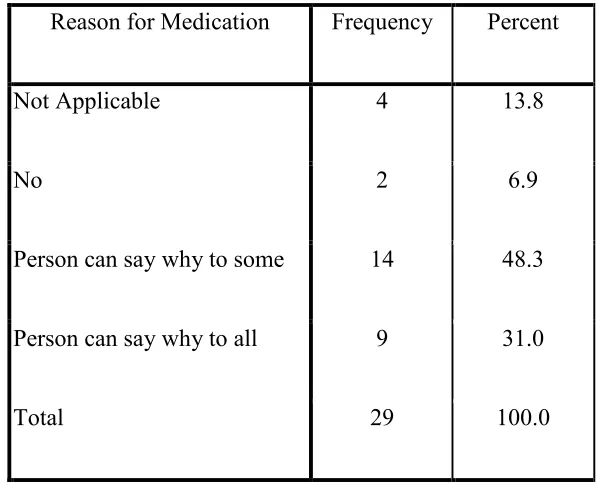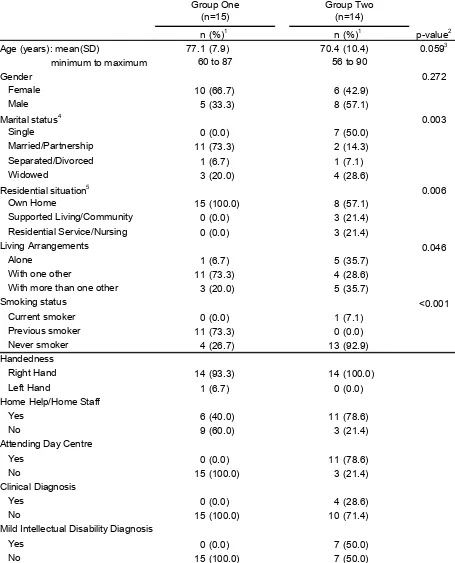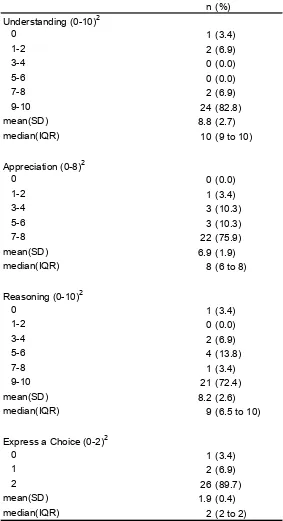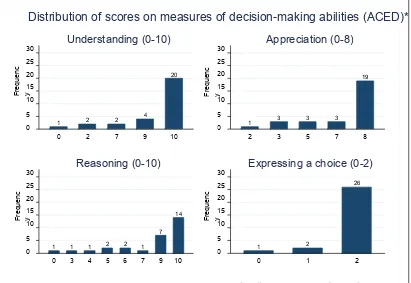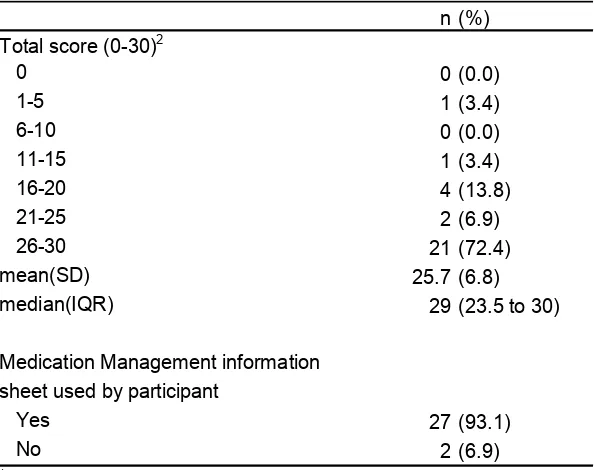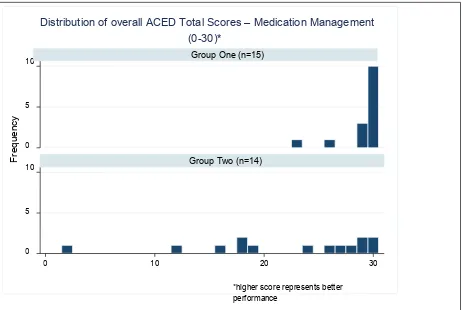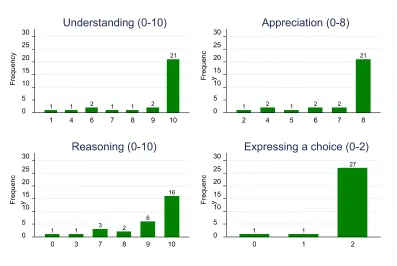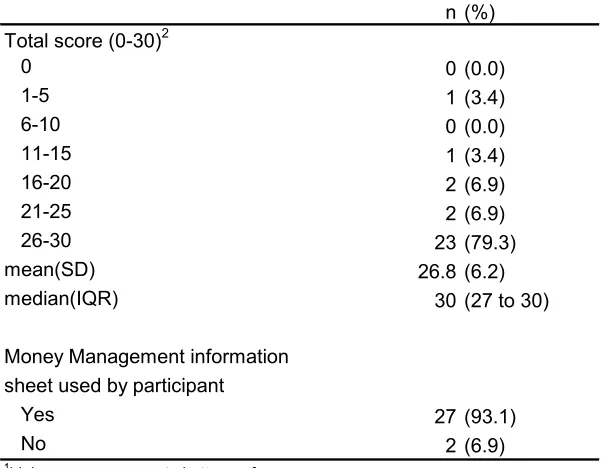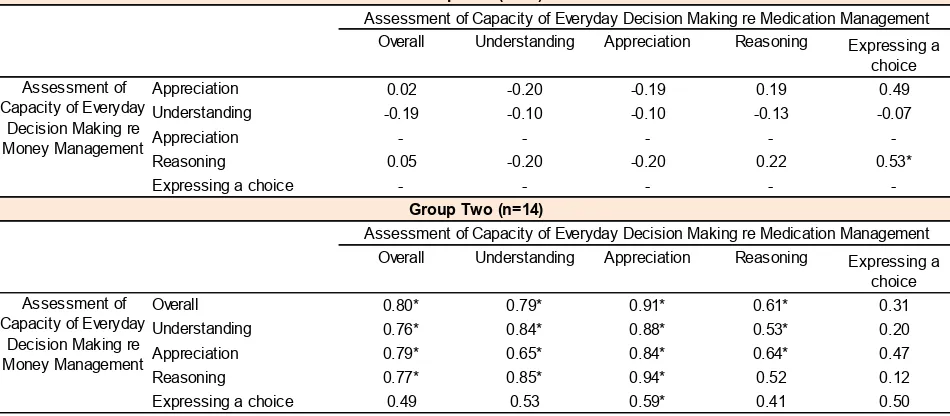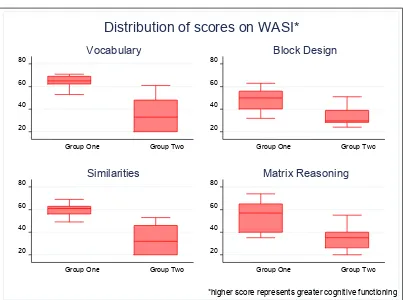1
Factors Associated with Decision Making Capacity in Older Adults
A thesis submitted to
The University of Dublin, Trinity College Dublin
In fulfilment for the degree of
Doctor in Philosophy
Maria Corrigan
School of Psychology, Trinity College Dublin
Supervisor: Prof. Kevin Tierney, School of Psychology, Trinity College
Dublin
Submitted: December 2016
Revisions submitted: May 2018
i
Declaration
I declare that this thesis has not been submitted as an exercise for a degree at
this or any other university and it is entirely my own work.
I agree to deposit this thesis in the University’s open access institutional
repository or allow the Library to do so on my behalf, subject to Irish
Copyright Legislation and Trinity College Library conditions of use and
acknowledgement.
Signed: __________________
Maria Corrigan
ii
Summary
Making our own decisions goes to the heart of our autonomy. Decision Making
Capacity (DMC) carries enormous significance for all people. Increasingly the DMC of
older adults can be queried, this can arise for a myriad of reasons, at the time of which the
individual may have a diagnosis of a medical, neurological, psychiatric disorder or be
simply aging. Each of these latter conditions has potential for an adverse impact on
cognitive skills that underpin DMC.
DMC is a multifaceted and dynamic concept. In recent times much consideration
has been given to the adverse impact upon it by aging and the associated decline in
cognitive functioning.
The aim of this study was to explore decision making capacity in older people and
to examine if relationships are present between decision making abilities and a number of
factors not previously explored and if there was a contribution to be made to develop
further an existing model of DMC, The Person-Task Fit Model. The factors being explored
included cognitive reserve and participation in decision making.
I recruited 32 participants through Day and Residential Centres, Active Retirement
Groups, General Practitioners (GPs), Community Groups and word of mouth (posters etc.).
3 participants became unwell and did not complete the research (one had completed one
session, another had completed two sessions and a third had completed three sessions)
resulting in a remaining 29 participants.
Participants were met individually to discuss project, they were also given an
information sheet which was talked through in detail with them at an appropriate pace with
their understanding being monitored. Measures were taken including for example, an easy
to read information sheet and consent form, inviting a third party known and familiar to the
iii
individuals’ rights to make their own decisions and to a presumption of their capacity to do
so and yet to be aware ethically of their potential vulnerability.
Data were collected for two groups of 29 participants (16 Females and 13 Males),
aged between 56 years and 90 years, (M=73.8years, SD=9.6). Group One (n=15) was older
adults at low risk of impaired DMC, (i.e. without clinical diagnosis and not receiving
support). Group Two (n=12) was older adults at increased risk of impaired decision
making capacity, (i.e. with clinical diagnosis or requiring support). Data collection took
place at a location convenient to the participant. No participant was paid to take part.
For each participant a semi structured interview with a questionnaire was
conducted and the following assessments were also administered: ACED, LEQ, WASI and
DRS. These yielded data with regard to Decision Making Abilities (health and finance
domains), Cognitive Functioning, Cognitive Reserve, Physical Activity and Preference and
Participation with regard to decision making.
Statistically significant positive relationships were observed between decision
making abilities and cognitive reserve (rs=0.45, p < 0.05; rs=0.61, p < 0.05) and between
decision making abilities and participation in decision making (rs=0.69, p < 0.05; rs=0.65, p
< 0.05).
Results suggested that models of DMC may be informed further by the
incorporation of the construct of cognitive reserve and life experiences, such as
participation in decision making. This may contribute to explanations for DMC variances
and to supports and opportunities provided by services to individuals over their life span.
Further study is required. All individuals reported enjoying their participation in the
research.
The study had some limitations, including the small number of participants. New
avenues of research are suggested including the systematic evaluation of the impact of
iv
Acknowledgements
This PhD has been a journey that would not have been possible without the input of
a number of exceptional people that I now have the opportunity to acknowledge and thank.
My Supervisor Dr Kevin Tierney provided much appreciated guidance, wisdom
and encouragement throughout for which I thank him. I also thank Dr Tim Trimble and Dr
Michael Gordon.
Whilst the number of participants in this study was relatively small, each
represented a generosity of time, spirit and experience without which this study could not
have happened. I deeply appreciate the participation so willingly given and I thank each.
I appreciate the support and encouragement of Hospitaller Order of St John of God,
Peamount Healthcare, Donegal Branch of Alzheimer’s Association, Milford Over 65’s
Group, Trialough Older Persons Centre, Caretakers of the Rossnakill Community Centre
and Milford Community Hall, Ms Jacinta Mulhere, CNS and GP Dr Margaret Gilligan.
Dr Jason Karlawish and Dr Michael Valenzuela were very generous in sharing their
assessment tools, answering my queries and providing encouragement. Dr Daniel Marson
and Dr Melissa Finucane generously provided clarification and encouragement. I
acknowledge the work and research by all I reference in this thesis. I am very appreciative
to Dr Levinson and the great team at the Human Services Research Institute,
Massachusetts for their permissions. I gratefully acknowledge the support and assistance of
Dr Vicki Livingstone with the statistics for this study and a very special thanks to Dr
Elaine Lehane-Corrigan.
Finally, I would like to thank Niall, my Mum, Dad, Samantha, Mark and all my
amazing friends for their unending encouragement, support and caffeine. I finish with a
quote that I thought particularly appropriate to this study.
Decision is a risk rooted in the courage of being free
v
Table of Contents
Declaration i
Summary ii
Acknowledgements iv List of Tables and Figures x
Glossary xvii
1.
Abstract
22.
Introduction
3Literature Search Strategy 3
Context 4
2.01 Definition 4
2.02 Decision Making Process 5
2.03 Prevalence 6
2.04 Social and Legal Context 8
Theoretical Models of Decision Making Capacity 18
2.05 Conflict between Models/Theory 22
2.06 Gaps within Theories and Models 23
Assessment of Decision Making Capacity 25
2.07 Clinicians’ Practice 33
2.08 Areas of DMC and Frequently Used Assessment Tools 40
2.09 Everyday Decision Making 43
2.10 Risk 49
DMC – Ethical Challenges 51
Previous DMC Research 57
2.11 Cognitive Functioning and Cognitive Aging 59
2.12 Older Adults 68
2.13 Older Adults with Intellectual Disability 81
vi
Preference to Participate in Decision Making 87
Participation in Decision Making 89
Cognitive Reserve 93
Summary and Study Rationale 106
3.
Methodology
112Ethical Approval and Issues 112
Participants 112
3.01 Group One 113
3.02 Group Two 113
Materials and Procedures 114
3.03 Assessment of cognitive functioning and status 117
Wechsler Abbreviated Scales of Intelligence (WASI) 117
Dementia Rating Scale – 2 (DRS-2) 119
3.04 Demographics 120
3.05 Preference re Decision Making 122
3.06 Participation in Decision Making 123
3.07 Assessment of Cognitive Reserve 125
3.08 Assessments of Elements of Decision Making Capacity 127
3.09 Physical Activity/Exercise 129
3.10 Data Table 130
4.
Results
1324.1: Sociodemographic and Clinical Background – Overall and By Group 134
vii
4. 3: Hypotheses One – A Relationship will be indicated between Elements of
DMC and Cognitive Factors 161
4.4 Hypotheses Two – A Relationship will be indicated between Elements of
DMC and Cognitive Reserve Markers 178
4.5 Hypotheses Three 200
a. A Relationship will be indicated between Elements of DMC and
An Individual’s Preference to Participate in Decision Making.
b. A Relationship will be indicated between Elements of DMC and
An Individual’s Participation in Decision Making
5.
Discussion 222
Sociodemographic and Clinical Background 222
Decision Making Abilities 224
Hypotheses One – A Relationship will be indicated between Elements of DMC
and Cognitive Factors 228
Hypotheses Two – A Relationship will be indicated between Elements of DMC
and Cognitive Reserve Markers 229
Hypotheses Three 230
a. A Relationship will be indicated between Elements of DMC and An
Individual’s Preference to Participate in Decision Making.
b. A Relationship will be indicated between Elements of DMC and An
Individual’s Participation in Decision Making
viii
Limitations 240
Future Research 242
Assessment Tools 245
Conclusion 246
6. Appendices
i. Appendix A Letter of Approval – Ethics 249
ii. Appendix B Information Sheets and Consent Forms
(Regular) 252
iii. Appendix C Information Sheets and Consent Forms
(Easy to Read) 256
iv. Appendix D Section II, Choice, National Consumer
Information Survey (2010)
Levinson et al. (2005) 261
v. Appendix E Questionnaire – Demographics, Participation in & Preference for Decision Making 269
vi. Appendix F Lifetime of Experiences Questionnaire (LEQ)
279
vii. Appendix G Assessment of Capacity of Everyday
Decision-Making (ACED) –
Templates/Forms 305
ix
Decision Making (ACED) – Measures Yielded 330
ix. Appendix I ACED Data Coding 333
x. Appendix J Table J.01 Summary Statistics (original) for
Measures of Preference in Decision-Making
Table J.02 Summary Statistics (original) for
Measures of Preference in Decision-Making
by Group 354
xi. Appendix K Table K.01 Summary Statistics (original) for
Measures of Participation in Decision Making
Table K.02 Summary Statistics (original) for
Measures of Participation in Decision-Making
by Group 356
x
List of Tables and Figures:
Tables
Table 2.1 ECF Impairments Associated with Lesion Location(Royall, 2002) 60
Table 2.2 Capacity Domains – Scope of Abilities and Skills Required
(Moye & Marson, 2007) 70
Table 2.3 Medical Decision Making Capacity Associations with Cognitive Measures
(Moye & Marson, 2007) 72
Table 2.4 Cognitive Abilities Associated with Elements of MDMC (Moye et al 2013)
74
Table 4.1 Demographic Characteristics of Participants (N=29) 135
Table 4.2 Statistics for Use of Prescribed Medication (N=29) 136
Table 4.3 Results for Participants’ Explanations for Medication Use(N=29) 137
Table 4.4 Demographic Characteristics of Participants by Group 139
Table 4.5 Performance of All Participants on ACED Measures of Decision Making
Abilities (Medication Management) (N=29) 141
Table 4.6 Overall ACED Total Scores (Medication Management) for Participants and
Use of Information Sheet for All Participants (N=29) 143
Table 4.7 Performance of Participants on Elements of Decision Making (Medication
Management) by Group (2 Groups) 145
Table 4.8 Performance of All Participants on Measures of ACED(Money
xi
Table 4.9 Overall ACED Total Scores (Money Management) and Use of Information
Sheet for All Participants (N=29) 150
Table 4.10 Performance on Elements of Decision Making (ACED – Money
Management) by Group 153
Table 4.11 Other Factors Referenced by Participants During ACED Assessment
(Medication and Money Management) 156
Table 4.12 Spearman's Correlation between ACED Measures (Medication
Management) and ACED Measures (Money Management) for All
Participants (N=29) 160
Table 4.13 Spearman's Correlation between ACED Measures (Medication
Management) and ACED Measures (Money Management) by Group (2
Groups) 161
Table 4.14 Summary Statistics Cognitive Functioning Measures (WASI) (N=29) 163
Table 4.15 Cognitive Functioning Measures (WASI) by Group 164
Table 4.16 Summary Statistics for DRS-2 Measures of Cognitive Status (N=29) 166
Table 4.17 DRS-2 Measures of Cognitive Statusby Group (2 Groups) 167
Table 4.18 Spearman's Correlation between Elements of DMC (Medication
Management) and Cognitive Functioning Measures (WASI) (N=29) 170
Table 4.19 Spearman's Correlation between Elements of DMC (Medication
Management) and Cognitive Functioning Measures (WASI) by Group (2
Groups) 171
Table 4.20 Spearman's Correlation between Elements of DMC (Money Management)
xii
Table 4.21 Spearman's Correlation between Elements of DMC (Money Management)
and Cognitive Functioning Measures (WASI) by Group (2 Groups) 174
Table 4.22 Spearman's Correlation between Elements of DMC (Medication
Management) and Measures of Cognitive Status (DRS-2) for All
Participants (N=29) 175
Table 4.23 Spearman's Correlation between Elements of DMC (Medication
Management) and Measures of Cognitive Status (DRS-2) by Group (2
Groups) 176
Table 4.24 Spearman's Correlation between Elements of DMC (Money Management)
and Measures of Cognitive Status (DRS-2) for All Participants (N=29) 177
Table 4.25 Spearman's Correlation between Elements of DMC (Money Management)
and Measures of Cognitive Status (DRS-2) by Group (2 Groups) 178
Table 4.26 Summary Statistics for LEQ Measures of CR All Participants (N=29) 180
Table 4.27 LEQ measures of Cognitive Reserveby Group (2 Groups) 181
Table 4.28 Frequency of Physical Activity for All Participants (N=29) 184
Table 4.29 Physical Activity Category for All Participants (N=29) 185
Table 4.30 Frequency of Physical Activity by Group (2 Groups) 187
Table 4.31 Physical Activity Category by Group (2 Groups) 188
Table 4.32 Present Moderate Physical Activity by Group (2 Groups) 189
Table 4.33 Spearman's Correlation between Assessment of Capacity of Everyday
Decision Making (ACED – Medication Management) and Measures of CR
xiii
Table 4.34 Spearman's Correlation between Assessment of Capacity of Everyday
Decision Making (ACED – Medication Management) and Measures of CR
(LEQ) by Group (2 Groups) 192
Table 4.35 Spearman's Correlation between Assessment of Capacity of Everyday
Decision Making (ACED – Money Management) and Measures of CR
(LEQ) for All Participants (N=29) 194
Table 4.36 Spearman's Correlation between Assessment of Capacity of Everyday
Decision Making (ACED – Money Management) and Measures of CR
(LEQ) by Group 195
Table 4.37 Relationship between ACED (Medication Management) and Physical
Activity Category during each Life Stage for All Participants (N=29) 197
Table 4.38 Relationship between ACED (Money Management) and Physical Activity
Category during each Life Stage for All Participants (N=29) 200
Table 4.39 Summary Statistics (converted) for Measures of Preference re
Decision-Making for All Participants (N=29) 203
Table 4.40 Preference re Decision-Making Participation by Group (converted) 205
Table 4.41 Summary Statistics (converted) for Measures of Participation in
Decision-Making for All Participants (N=29) 206
Table 4.42 The Choice of Staff/Home Help for Individuals (N=29) 209
Table 4.43 The Choice of Keyworker for Individuals (N=29) 209
Table 4.44 Participation in Decision-Making by Group (converted) 211
Table 4.45 Spearman's Correlation between Measures of Elements of DMC
(Medication Management) and Measures of Preference re Decision Making
xiv
Table 4.46 Spearman's Correlation between Measures of Elements of DMC
(Medication Management) and Measures of Preference re Decision Making
by Group (2 Groups) 214
Table 4.47 Spearman's Correlation between Measures of Elements of DMC (Money
Management) and Measures of Preference re Decision Making for All
Participants (N=29) 215
Table 4.48 Spearman's Correlation between Measures of Elements of DMC (Money
Management) and Measures of Preference re Decision Making by Group (2
Groups) 216
Table 4.49 Spearman's Correlation between Measures of Elements of DMC
(Medication Management) and Measures of Participation re Decision
Making for All Participants (N=29) 218
Table 4.50 Spearman's Correlation between Measures of Elements of DMC
(Medication Management) and Measures of Participation re Decision
Making for Group Two (N=14) 219
Table 4.51 Spearman's Correlation between Measures of Elements of DMC (Money
Management) and Measures of Participation re Decision Making for All
Participants (N=29) 220
Table 4.52 Spearman's Correlation between Measures of Elements of DMC (Money
Management) and Measures of Participation re Decision Making for Group
xv
Figures
Figure 4.1 Distribution of Scores on Measures of Decision-Making Abilities in ACED
(Medication Management) for All Participants, N=29 142
Figure 4.2 Distribution of Overall ACED Total Scores (Medication Management) for
All Participants, N=29 144
Figure 4.3 Distribution of Overall ACED Total Scores (Medication Management) by
Group 146
Figure 4.4 Distribution of ACED Scores (Money Management), for All
Participants, N=29 149
Figure 4.5 Distribution of Overall ACED Total Scores (Money Management) for All
Participants, N=29 151
Figure 4.6 Distribution of Overall ACED Total Scores (Money Management) by
Group 154
Figure 4.7 Distribution of WASI Subtest Scores by Group 164
Figure 4.8 Distribution of WASI “IQ” Scores by Group 165
Figure 4.9 Distribution of DRS-2 Scores by Group 168
Figure 4.10 Distribution of LEQ Total Scores by Group 182
Figure 4.11 Distribution of LEQ Scores for Each Life-Period by Group182
Figure 4.12 Frequency of Current Physical Activity 185
Figure 4.13 Physical Activity Category for All Participants, N=29 186
xvi
Figure 4.15 Distribution of Scores (converted) re Preference in Decision Making for all
Participants, N=29 203
Figure 4.16 Distribution of Scores (converted) re Preference in Decision Making for all
Participants, N=29 204
Figure 4.17. Distribution of Scores (converted) re Preference to Participate (Money
subscale) by Group 205
Figure 4.18 Distribution of Scores (converted) on Participation in Decision-Making
scale and subscales for All Participants, N=29 207
Figure 4.19 Distribution of Scores (converted) on Participation in Decision-Making
scale and subscales for All Participants, N=29 208
Figure 4.20 Distribution of Total Scores (converted) re Participation in
xvii
Glossary
• Decision Making Capacity (DMC)refers to an individual’s situation-specific
ability to make a decision at a specific time (Moberg & Rick, 2008).
• Mental Competence refers to a legal construct referring to an individual’s capacity
to decide or perform activities of daily living (Moberg & Kniele, 2006);
• Mental Capacity is a clinical construct referring to an clinician’s opinion of an
individual’s abilities to make decisions or perform certain functions (Moye, 2007);
• Cognitive Reserve(CR) is theorised to provide a protective buffer for cognitive
functioning from the adverse affects of pathology, injury and aging (Stern, 2002;
Richards and Deary, 2005).
Abbreviations Frequently Used
• APA –American Psychological Association
• ABA –American Psychological Association
• ABI – Acquired Brain Injury
• AD –Alzheimer's Disease
• ADL – Activities of Daily Living
• CAS– Cognitive Activities Scale
• CNS – Central Nervous System
xviii
• DMC –Decision Making Capacity
• FDMC – Financial Decision Making Capacity
• HSE – Health Service Executive (Ireland)
• ID –Intellectual Disability
• IOMCommittee– Institute of Medicine Committee
• MCI –Mild Cognitive Impairment
• MDMC – Medical Decision Making Capacity
• PD –Parkinson’s Disease
• TBI –Traumatic Brain Injury
• STM – Short Term Memory
• UNCRPD– United Nations Convention on the Rights of Persons with Disabilities
2
1. Abstract
Making our own decisions goes to the heart of our autonomy. Increasingly decision
making capacity (DMC) of older adults is questioned. The aim of this study was to explore
DMC in older people and examine for associations between decision making abilities and
factors not previously explored, including cognitive reserve (CR) and participation in
decision making. Data were collected for two groups of 29 participants (16 Females and 13
Males), aged between 56 years and 90 years, (M=73.8years, SD=9.6). Group One (n=15)
was older adults at low risk of impaired DMC, (i.e. without clinical diagnosis and not
receiving support). Group Two (n=12) was older adults at increased risk of impaired
decision making capacity, (i.e. with clinical diagnosis or requiring support). A semi
structured interview and ACED, LEQ, WASI and DRS assessments were administered for
each. These yielded data regarding decision making abilities (health and finance domains),
CR, cognitive functioning and preference/participation in decision making. Statistically
significant positive relationships were observed between decision making abilities and CR
(rs=0.45, p < 0.05; rs=0.61, p < 0.05) and between decision making abilities and
participation in decision making (rs=0.69, p < 0.05; rs=0.65, p < 0.05). Results suggested
that DMC models may be informed further by consideration of CR and life experiences,
such as participation in decision making. This may contribute to explanations for DMC
variances and to supports and opportunities provided by services to individuals over their
life span. Limitations of the study, including the small number of participants are
discussed. Further study is required. New research avenues are suggested including
3
2.
Introduction:
Making decisions for oneself is an aspect of life perhaps taken for granted by most
adults in the free world. What to wear, what to have for breakfast, when to have breakfast,
making purchases, for example buying a new pair of shoes, when and if to give someone a
gift, are all actions precipitated by earlier decisions that most adults make for themselves.
These decisions may be influenced by environmental factors and consultations with
appropriate others, but are fundamentally decisions that most adults make and act on by
themselves without much consideration.
However, for some people, the ability to make decisions can be questioned and in
some instances denied on the grounds of impaired decision making capacity. This study
seeks to explore factors that may be associated with the decision making capacity of older
adults so as to add to existing knowledge. This may then inform future developments of
theory and inform supports for the maintenance and enhancement of decision making
capacity.
So what is Decision Making Capacity (DMC) and whose DMC is impaired?
Literature Search Strategy
Initial search of literature was achieved using the following key terms “Decision
Making Capacity”, “Mental Capacity”, “Decision Making Competence”, “Financial
Decision Making Competency”, “Financial Decision Making Capacity”, “Health Decision
Making Capacity”, “Medical Decision Making Capacity”, “Medical Decision Making
Competency”, “Health Decision Making Competency”, “Consent Competency”, “Consent
Capacity”and “Everyday Decision Making”. These terms were then combined with the
following terms to identify more specific literature for later sections; “Older Adults”,
4
“Preference to participate in decision making”, “Participation in decision making”,
“Reserve “Brain Reserve” and “Cognitive Reserve”. These search terms reflect the focus
of this study on Medical Decision Making Capacity (MDMC) and Financial Decision
Making Capacity (FDMC) in the context of everyday decision making for older adults.
In addition a separate search was conducted specifically for “Reserve “Brain
Reserve” and “Cognitive Reserve”.
These searches were undertaken for English language articles using the search
engines PsychArticles, PsychInfo, PubMed, and MedLine.
Context
2.01 Definition.
DMC refers to a person’s ability to make their own decisions. A look at the area of
DMC leads to encounters with the terms Mental Competence, Mental Capacity and
Decision Making Capacity. These terms often lack clarity and are sometimes used
interchangeably. There is debate as to the definitions and characteristics of each of these,
illustrating the diversity of thinking within the field. This experience has been commented
upon and highlighted by a number of authors (Eyler & Jeste, 2006; Hotopf, 2006; Moberg
& Kniele, 2006; Moye, 2007).
As thinking evolved regarding DMC, so too did definitions, as illustrated in the
following overview. Originally DMC was conceptualised as global. It was defined and
determined in accordance with diagnoses or status, for example the presumption that
someone with intellectual disability (ID) or mental health difficulties did not have the
capacity to make decisions (Grisso, 1986). The presence of a disability or a disorder
5
DMC is now conceptualised functionally. It is succinctly reflected by Moberg and
Rick (2008) who defined DMC as referring to an individual’s situation-specific ability to
make a decision at a specific time.
Although there is not universal acceptance of the functional approach to DMC,
there is widespread usage of it as reflected in legislation (Ireland – The Assisted Decision
Making (Capacity) Act 2015; England & Wales - The Mental Capacity Act, 2005),
national guidance (Ireland – HSE, 2013) and professional practice guidelines (BPS, 2006;
ABA/APA, 2008).
2.02 Decision Making Process.
Notwithstanding the various debates and usage of terms and definitions, consensus has
emerged regarding the decision making process (Appelbaum & Grisso, 1988, 1995);
Marson & Moye, 2007; Moye, 2007; Smyer, 2007), which is observed to include the
following key elements:
a) Understanding of information relevant to the choice
b) Retaining or keeping information in mind for long enough to come to a decision
c) Appreciation of the significance of a choice
d) Ability to reason or rationally evaluate a choice
e) Expression of a choice – Communicating Decision
Only when one of these key features is compromised should it be implied that someone
is unable to make a particular decision and that an adverse conclusion be made regarding
their DMC.
6
Whilst this dissertation is concerned specifically with the individual’s capacity to make
decisions and the factors that may impact on this, it is of note that there is presently a
growing interest within clinical and corporate governance with regard to decision making,
its process and practice and maximising the likelihood of ensuring that “good” decisions
are made,. A vast array of research has also been undertaken specifically exploring
decision making itself separate to the question of capacity.
For the purposes of this dissertation, DMC is conceptualised as functional and
reflective of the four elements Understanding, Appreciation, Reasoning and Expressing a
Choice.
2.03 Prevalence.
A number of international studies have been undertaken to establish prevalence of
incapacity regarding to decision making. These studies were conducted in various settings,
including inpatient settings, psychiatric and acute medical care settings, individuals
diagnosed with dementia and also older adults. However there are no estimates of the
prevalence of impaired DMC within Irish populations.
Research by Amnesty International Ireland on DMC within mental health in the
Republic of Ireland drew upon prevalence studies undertaken in the United Kingdom
(Amnesty International Ireland, 2009).
In the United Kingdom (UK), a study by Raymont et al. (2004) recruited 302
consecutive acute medical care patients over a period of eighteen months. Of this number,
it was estimated that approximately 40% lacked capacity to make decisions. Seventy two
(24%) patients were severely cognitively impaired, unconscious or unable to express a
choice and were automatically assigned to the incapacity group. Seventy one (24%)
7
were interviewed by the researchers of which, 31% were judged to lack capacity. Raymont
et al. reported that clinical teams rarely identified incapacity with just under a quarter of
those identified by the researchers as lacking capacity being identified by the clinical team.
The study observed that the incapacity identified was associated with impaired cognitive
functioning, older age and lower educational attainment.
In a review of previous research Hotopf (2005) concluded that one third of
inpatients within a general hospital setting may lack capacity and that this incapacity is
driven by cognitive impairment caused by delirium or dementia. He contrasted this with
incapacity experienced by psychiatric inpatients which was mainly related to psychotic
illness.
A systematic review of previous research regarding capacity for patients with
psychiatric disorder was conducted by Okai et al., (2007) who identified and reviewed 51
studies meeting their inclusion criteria. These indicated that the prevalence of incapacity
amongst patients with psychiatric disorders was between 22% - 44%, with the lower range
being demonstrated amongst patients with depression and the higher range amongst
patients with schizophrenia. The reviewers noted the almost identical finding of prevalence
in similar situations made by two separate studies, one in Germany and one in the USA.
Higher prevalence of incapacity amongst patients with a psychotic disorder than amongst
patients with a non-psychotic disorder was reflected throughout all studies.
Studies reviewed for this study evidenced the prevalence of incapacity to be higher
within certain clinical groups and to be associated with higher age and more inconsistently
with lower educational standards. A number of studies reported an association with lower
educational standards whilst in contrast others reported no such association (Raymont et al,
2004; Hotopf, 2006; Okai et al, 2007; Porrino et al., 2015). This will be considered further
8
In commenting on the findings by Raymont et al’s (2004), Hotopf (2006) noted that
between one quarter and one half of patients admitted to psychiatric hospitals were also
estimated to lack capacity to make treatment decisions. He asserted however, that the
important message to take from such research is that even in such a severe group, the
majority of people with psychiatric disorders were capable of making valid treatment
choices.
2.04 Social and Legal Context.
The struggle between autonomy and benefiance underpins the social and legal
context of DMC within the Republic of Ireland and many other countries including United
States (US), UK and Australia. A desire to protect adults perceived to be vulnerable,
challenges our regard and observance for their autonomy and independent decision
making. Mental capacity and DMC can be affected by a number of conditions including
Acquired Brain Injury (ABI), dementia and ID. Thus older people, adults with an age
related disorder, adults with an ID, adults with an ABI, adults experiencing mental health
difficulties, adults with autism and adults with impaired cognitive functioning can be some
of those individuals who frequently find their decision making questioned, denied or
bypassed. Individuals with diagnoses and in long term residential care are not only at risk
of impaired DMC but are also at risk of having their DMC underestimated and thereby
denied the right to autonomous choice (Volicer & Ganzini, 2003). Moye, Marson and
Edelstein (2013) observed that traditionally requests to assess DMC tended to arise for
individuals with ID or mental health difficulties.
The National Intellectual Disability Database (NIDD – Republic of Ireland) was
established in 1995. Its role is to provide information regarding every person with an ID in
receipt of a service or who requires or expects to require a service, to the Department of
9
registered on the NIDD at the end of December 2014 (Kelly, 2015). Based on 2011 census
figures, this represents a prevalence rate of just over 6 (6.08) per 1,000 population. The
prevalence for individuals with mild level of ID is just under 2 (1.99) per 1000 and the rate
for moderate, severe or profound level of ID was 3.58 per 1000. Traditionally the
prevalence rate for individuals with mild ID has been under reported, this is believed to
still be the case.
ABI is a non-progressive injury to the brain which occurs after birth. There are no
epidemiological data available with regard to ABI in the Republic of Ireland, however
experts, researchers and groups working in the area estimate that approximately 13,000
people a year survive and live with a brain injury (Acquired Brain Injury Ireland, 2017).
The Irish National Health Services provider, the Health Services Executive (HSE)
reported stroke to be the leading cause of adult disability. Over 10,000 people have a
stroke each year in Republic of Ireland, approximately one third of people who have a
stroke, will have another stroke within 5 years and there are 30,000 people who have
stroke related disability (National Stroke Programme).
Mental health difficulties vary and can include for example, depression, anxiety
disorders, substance abuse and psychoses. The experience is also varied, some individuals
may experience once off difficulties, others may experience intermittent difficulties and for
some those difficulties may be persistent and chronic. The impact on an individual’s
functioning, their thinking, perceptions, emotions and judgement can range from mild to
severe. There are limited data regarding the prevalence of mental health difficulties within
the Republic of Ireland. Some individuals may be admitted to a hospital or clinic setting
for treatment, others may attend a family doctor (GP) or mental health professional. It is
estimated however that one in four individuals in Republic of Ireland will experience
10
Dementia is a multifunctional disorder where memory, reasoning, judgement and
other higher mental processes are lost. Typically alterations in personality and modes of
social interaction accompany these cognitive deficits. It can occur in different forms,
including Alzheimer’s disease (AD), senile and vascular. In the Republic of Ireland it is
estimated that 42,000 people are likely to have dementia, these figures are projected to
increase to between 65,000 and 140,000 over the next 30 years (Cahill et al., 2012).
Generally life expectancy has improved; individuals are living longer, resulting in
increasing numbers of older adults and increasing numbers of age related disorders.
Demographic changes indicating an increased older adult population in the developed
world have been referenced by a number of researchers (Moye, Armesto, & Karel, 2005;
Moberg & Rick, 2008; Shreve-Neiger, Houston, Christopher & Kier, 2008; Finucane &
Gullion, 2010; Demakis, 2013; Dunn & Alici, 2013; Moye et al., 2013; Gross, 2017). They
have reported that changing demographics have resulted in increasing requests to assess
DMC of older adults.
Awareness in recent times has also increased with regard to individuals’ rights,
autonomy and their quality of life. There is also a greater awareness about the vulnerability
of some adults and a consequent desire to protect them. Some adults struggle to make
decisions or may make decisions that are unsafe or not in their best interests, resulting in
for example, vulnerability to danger, loss and/or exploitation. This gives rise to autonomy
versus beneficence struggle with regard to decision making for those adults considered to
be vulnerable. This consequently leads to situations wherein the duty of beneficence – to
protect or safeguard the welfare of an individual –supersedes the individual’s autonomy
(Trachsel, Hermann, & Biller-Andorno, 2015; Demakis, 2013; Smyer, 2007, Moye &
11
Thus the impact of sociodemographic factors such as those outlined above are seen
in the demonstrable rise of requests for determination of capacity internationally (Moberg
& Rick, 2008; Demakis, 2013; Dunn & Alici, 2013; Moye et al., 2013; Gross, 2017). On
the impact of this, Moye et al. have commented that “capacity rights now permeate the
fabric of everyday life” (p.158).
Jurisdictions within many countries, including the Republic of Ireland, UK, United
States (US) and Australia have experienced an evolution in the concept of capacity.
Historically the Republic of Ireland is similar to the US, with the legal origins of the
concept of capacity found in English law. Moye et al. (2013) reported that the first
recorded use of the term capacity in English language emerged in the late fifteenth century
when in England it was used to describe “mental receiving power, ability to take in
impressions, ideas, and knowledge”, “active power of mind and talent” and in legal
parlance as “legal qualification” (p.161).
Until recently there was no legislative framework in the Republic of Ireland with
regard to decision making for those individuals lacking capacity to make decisions
themselves. Unless a legal provision such as Ward of Court/Legal Guardianship/ power of
attorney was in place, Irish law did not permit another person to make a decision for any
adult. This resulted in uncertainty in all areas requiring decisions and consequently the
evolution of “Best Interests” practice.
For individuals identified as lacking capacity, the primary mechanisms under Irish
law historically were the Lunacy Regulation (Ireland) Act (1871) and the Powers of
Attorney Act (1996). The former legislation made provision for wardship and the Ward of
Court system. It was paternalistic in practice and adopted a global approach to capacity, i.e.
the individual either had capacity for all decisions or capacity for no decisions. This
12
Attorney Act (1996) made provision for a person with capacity to plan for a future loss of
capacity by executing an enduring power of attorney with regard to certain decisions. Both
mechanisms made provision for the appointment of substitute decision-makers.
Traditionally for individuals such as those within the groups identified above (i.e.
ID, mental health, dementia, ABI etc), a presumption of DMC was not the “default”
practice within a range of decision making areas, such as health, finance, welfare etc. An
informal “best interests” approach appeared to apply, with consent for activities such as
dental treatment, medical treatment, banking being accepted from care staff or family
members. Yet legally no adult could provide consent with regard to any activity on behalf
of another adult unless a wardship or power of attorney situation pertained. In July 2015,
there were approximately 2,600 designated Wards of Court in Ireland (Relate, 2016). For
many people therefore a legal limbo existed which became more pronounced as awareness
of individual rights and autonomy and of the deficits in Irish law increased.
The Law Reform Commission (LRC) is an independent statutory body within the
Republic of Ireland whose main aim is to keep the law under review and to make practical
proposals for its reform. It noted in a consultation paper on Vulnerable Adults, Capacity
and the Law (2005) that the paternalistic concepts “at the heart of the wardship system sit
somewhat uncomfortably with the more recent social and human rights models of
disability and the conception of capacity in functional terms” (Section 4.02, p.78). These
mechanisms were not in keeping with the European Convention on Human Rights (2003)
or the United Nations Convention on the Rights of People with Disabilities (2006), to both
of which the Republic of Ireland is a signatory. The LRC recommended the introduction of
new comprehensive legislation with regard to DMC and recommended repeal of existing
legislation such as the Marriage of Lunatics Act 1811. They recommended that new
13
than restrictive, adopt a functional approach to DMC and be compliant with constitutional
and human rights.
Increasing awareness of individuals’ rights with regard to autonomy resulted in
national policy and legislative developments such as the establishment of the National
Advocacy Service (NAS) in 2011, the Health Services Executive’s Strategy Time to move on from Congregated Setting: a strategy for Community Inclusion (2011), accompanied by the Department of Environment Community and Local Government’s, The National
Housing Strategy for People with Disability 2011-2016 (2011). The Regulations for the inspection and monitoring of residential service provision for both older adults and adults
with disabilities by the Health Information and Quality Authority (HIQA) include
standards on the exercise of choice and control by residents (Health Act, 2007).
Carey & Griffiths (2016) considered the impact of Irish policy and legislation on
how adults with learning disabilities make choices. They observed that both the United
Nations and European Conventions were the “main drivers for the development of policies
and legislation in promoting the rights of people whose mental capacity could be
questioned” (p.113).
A National Consent Policy was developed by the Health Services Executive (HSE,
2013) to guide HSE & HSE funded clinicians in matters regarding the provision of Health
and Social Care Services and was explicit regarding DMC. It directed that there must be a
presumption of capacity regarding the individual’s capacity for consent to or refusal of
examination, investigation or treatment. There must not be an assumption that an
individual lacks capacity,
...solely because of their age, disability, appearance, behaviour, medical condition
(including ID, mental illness, dementia or scores on cognitive function), their
14
decision that seems unwise to the health and social care professional. (Section 5.3, p.31)
It also directed that a finding that an individual lacked DMC on a particular occasion
did not mean that they lack DMC for other decisions or indeed for a similar decision at
another time. This is an explicit rejection of both the Status and Outcome approach. The general principles underpinning this national policy are that
..best practice favours a ‘functional’ or decision-specific approach to defining
decision-making capacity: that capacity is to be judged in relation to a particular
decision to be made, at the time it is to be made – in other words it should be issue
specific and time specific – and depends upon the ability of an individual to
comprehend, reason with and express a choice with regard to information about the
specific decision. (p. 29)
The functional approach to DMC recognises that there is a hierarchy of complexity in decisions and also that cognitive deficits are only relevant if they actually impact on
decision making. The HSE National Consent Policy (2013) emphasised the duty that exists
to maximise capacity. Best practice and human rights standards favour “supported
decision-making” where possible. This requires that efforts are made to support individuals
in making their own decisions where this is possible.
New legislation for the Republic of Ireland, the Assisted Decision Making (Capacity)
Act 2015, has now passed and was planned to become operational on a phased basis during
2016. Whilst there has been commencement of some parts of the legislation (Parts 1, 9 and
some of Part 8, October 2016), the remainder of the legislation has yet to commence.
This Assisted Decision Making (Capacity) Act 2015 seeks to establish a statutory
15
without help. When fully commenced, it will repeal the Marriage of Lunatics Act (1811)
and the Lunacy Regulation (Ireland) Act (1871). Significantly it changes the law from an
all or nothing approach to a flexible functional approach and recognises that capacity can
fluctuate in certain cases.
The Act defines capacity for decision making as the ability to understand, at the time
the decision is being made, the nature and consequences of the decision in the context of
the available choices. There is a presumption of capacity for all unless shown otherwise.
Under the Act an individual lacks capacity to make a decision if they are unable to:
• Understand information relevant to the decision
• Retain that information long enough to make a voluntary choice
• Use or weigh that information as part of the process of making the decision
• Communicate the decision
The Assisted Decision Making (Capacity) Act 2015 enables specific persons to support
an individual while enabling the individual to have their voice heard and wishes followed
where possible. It incorporates three types of decision-making options to respond to the
support needs that people may have with regard to decision-making capacity. These
decision-making options are Assisted Decision-Making, Co-Decision-Making and
Decision-Making Representative. Decisions can be made on personal welfare, property and
finance using any of these three options. The Act specifically excludes capacity or consent
with regard to marriage, civil partnership, judicial separation, divorce, the placing of a
child for adoption, the making of an adoption order, guardianship, sexual relations, serving
as a member of a jury and the making of a will. Within the legislation then is also
provision for enduring power of attorney and advance healthcare directive and it
16
Notably within the Criminal Justice Withholding of Information (Concerning Criminal
Offences Against Children and Vulnerable Persons) Act 2012 (Republic of Ireland) there is
a “rebuttable presumption of no capacity” regarding any person meeting the definition of
“Vulnerable Persons”. This definition is contained within the legislation and is the first
such statutory definition of vulnerable person and is relatively broad. This rebuttable
presumption of no capacity appears to reflect a status (global) approach and to also be at
odds with the HSE National Consent Policy and the new Assisted Decision Making
(Capacity) Act 2015.
Other countries have also introduced capacity legislation. Scotland introduced
legislation in 2000, with the The Adults with Incapacity Act (2000). It referred to an
individual who “lacks capacity” and defined “incapable” as meaning incapable of (a)
acting; or (b) making decisions; or (c) communicating decisions; or (d) understanding
decisions; or (e) retaining the memory of decisions. The Mental Capacity Act (2005) for
England and Wales became operational in 2007 and Northern Ireland introduced the
Mental Capacity Bill (2014). Similarly to the Republic of Ireland Act, this legislation
references “inability” orbeing “unable” in relation to the four elements of decision-making
for a specific decision. However, it requires that this inability to be the consequence of “an
impairment of, or a disturbance in the functioning of, the mind or brain”, requiring
therefore a diagnosis and impaired decision-making. In contrast the Irish legislation, the
Assisted Decision Making (Capacity) Act 2015, focuses specifically on functioning with
regard to the specific decision. While it specifies that the legislation applies to a “Relevant
Person” (RP), it defines RP as
(a) a person whose capacity is in question or may shortly be in question in respect of
one or more than one matter,
17
(c) a person who falls within paragraphs (a) and (b) at the same time but in respect
of different matters
All the legislation referred to above, reflect a functional approach to decision-making,
make provision for power of attorney and the appointment of a Public Guardian (referred
to as Director of Decision Support Office in Irish legislation). The Irish legislation differs
with its provision of three types of decision-making options to respond to the support needs
that people may have with regard to decision-making capacity.
Legal, social and sociodemographic factors drive the awareness of DMC and drive
the increasing demand for assessment. As our populations continue to grow, and the
number of people living longer and with various forms of cognitive impairment increases,
it is expected that the requests for DMC assessments will also rise (Clarke, Galbraith,
Woodward, Holland, & Barclay, 2015; Moberg & Rick, 2008; Demakis, 2013; Dunn &
Alici, 2013; Moye, Butz, Marson, & Wood, 2007; Gross, 2017). In considering the
legislative requirements regarding DMC, particularly Article 12 of the United Nations
Convention on the Rights of Persons with Disabilities (UNCRPD 2006), Clarke et al
observed that some legal interpretations of this article argue that there is no point at which
legal DMC is lost. Clarke et al’s paper is considered in greater detail in a later section.
It has been observed that requests for DMC assessments appear to escalate further
following the introduction of legislation with regard to DMC (BPS, 2006; Kornfeld,
Muskin, & Tahil, 2009). A contribution by Scottish Psychologists to the British
Psychological Society guidance for psychologists assessing capacity reported a significant
increase in requests for capacity assessments following the introduction of the Adults with
18
Theoretical Models of Decision Making Capacity and Empirical Research
The literature search undertaken identified studies that have explored DMC
and its many aspects, including its conceptualisation and assessment, ethical challenges,
associated factors and DMC within specific groupings of individuals.
An examination of previous research provides an overview of the journey in the
conceptualisation and understanding of DMC. Pioneering research by authors such as
Grisso and Appelbaum heralded the shift in perspective from conceptualising DMC as a
single unitary construct to its evolution to that of a multifaceted dynamic construct.
One of the earliest models of Decision Making Capacity posited DMC as a unitary
construct, determined by intellect. This resulted in a global view being taken to DMC and
is illustrated in the Status (or Diagnostic) Approach (BPS, 2006). It involved an
across-the-board global assessment of an individual. It viewed capacity in all-or-nothing terms; an
individual either has capacity for everything or capacity for nothing. It typically involved
concluding that a person had no legal capacity based on the presence of a disability or a
disorder rather than on an assessment of their actual decision-making capability.
Historically this approach was used to limit the decision-making of people with intellectual
disabilities and/or mental health needs (Grisso, 1986). Once an individual was considered
to lack capacity, this became a determination that was applied to every aspect of their lives
and functioning.
The Outcome Approach reflected another model of capacity whereby the
determination of a person’s capacity was based on an assessment of the projected outcome
of their preferred decision-making choice. An example of this is a nursing home resident
who chooses to place a €1000 bet on an outside horse in a race. As the horse is not
expected to win and a €1000 is viewed as a considerable amount of money, a
19
projected outcome. The subjective basis of this Outcome approach at times resulted in the
projection of the reviewer’s values onto the decision of the individual. Thus the wisdom
and “correctness” of the decision rather than the quality of the decision making was the
focus and determined the judgement reached regarding the person’s DMC. This resulted in
a significant loss of autonomy whereby the right to make unwise decisions was removed
(BPS, 2006).
Consideration of an individual’s autonomy and how to respect and support its
realisation by Grisso, Appelbaum, Buchanan and Wong amongst others, resulted in a
broadening of the concept of DMC as a unitary construct to the evolution of a
multidimensional perspective, heralding the Functional Approach. Moye et al. (2013)
observed that a paradigm shift in capacity theory occurred with the emergence of a
functional standard for incapacity in the United States. They asserted that the Uniform
Guardianship and Protective Proceedings Act (UGPPA; National Conference of
Commissioners on Uniform State Laws, 1982) provided recognition for the link between
diagnoses and abilities in its definition of an “incapacitated person”. This was then
articulated by Grisso in his pioneering conceptual model of capacity, initially proposed in
1986 as including six analytical characteristics common to all legal capacity assessments,
functional; contextual; casual, interactive, judgemental and dispositional. He revised this
model in 2003 and combined the contextual and functional characteristics to refer to them
as components. Grisso viewed the objective of an assessment to be the yielding of
information about those functional abilities of an individual appropriate to the capacity in
question. This identification of function in capacity was, Moye et al. asserted, the key
contribution of Grisso’s model and has deeply influenced those who followed (p.163).
20
The Functional Approach views DMC as decision specific and time specific with
the question therefore being, has an individual the capacity to make a particular decision at
this particular point in time? In Assessment of Capacity in Adults: Interim Guidance for Psychologists (2006) the BPS states that whilst the status (diagnostic) approach focuses
exclusively on the person, the functional approach emphasises the idea that capacity
reflects the interaction between a person’s functional abilities and a given situation. This
decision specific – person specific focus has informed the evolution of theory in this area
resulting in DMC being viewed as a dynamic multidimensional construct reflected upon a
continuum.
Symer (2007) continued the theoretical development of DMC as a multifaceted
dynamic construct and identified three interacting elements: the Person, the Process & the
Context. He asserted that using these three elements as a focus provided a framework for
thinking about DMC.
The essence of the functional concept of DMC is reflected in the New South Wales
Attorney General’s Department (Australia) assertion that
Capacity varies from person to person and from situation to situation.
Capacity is not something solid that you can hold and measure. Neither is it
something that is the same all the time. It is affected by a person's abilities
and by what's happening around them. . . . Also each person's capacity can
fluctuate, depending on things such as their mental and physical health,
personal strengths, the quality of services they are receiving, and the type
and amount of any other support. (Attorney General’s Department, 2008)
p.20-21.
Chalmers (2008) described capacity as a complex construct which refers to the
21
order to make a specific decision. The abilities that she identified reflect those commonly
accepted as elements of decision making, understanding, appreciation, reasoning and
expressing a choice.
Clarke et al. (2015) also explained the concept of DMC as referring to an
individual’s “ability to understand, retain and balance information, and communicate a
choice” (p.2). They observed it to be a psychological construct that in some countries has
been enshrined in legislation. They noted DMC to be effected by factors such as the
consumption of alcohol, ABI, ID or the presence of disorders such as dementia. The loss of
capacity is time specific as it can be temporary, fluctuating or permanent.
There are some commonalities that emerge from most of the models of DMC and
frameworks for assessment. All functional theories and models posited have identified
elements related to the individual and the situation as having significance in the decision
making process. The concept of decision making being an “interaction” is also a
commonality. The elements within this interaction have been developed and expanded by
researchers over the years. Wong et al. (2000), in agreement with Grisso asserted that
capacity reflected “an interaction between the individual’s relevant abilities and the
demands of the particular decision making task” (p.304). Smyer (2007) identified the
Person, the Process and the Context. The American Psychological Association (APA) in
conjunction with the American Bar Association (ABA) (2008) expanded Grisso’s model to
include nine identified elements when developing a framework to guide assessment. In the
Person-Task Fit, Finucane et al. (2005) proposed an alternative framework that views DMC as the degree of congruence between characteristics of the decision maker and the
demands of the task and content. All models identified individual elements related to the
individual and the situation as having significance in the decision making process. These
22
2.05 Conflict between Models/Theories:
There are strong conflicting views re Global Capacity versus Functional Capacity
as being indicative of DMC.
Proponents of the concept of Global Capacity asserted that a measure of global
functioning and diagnosis sufficed to determine capacity in all decision making situations.
This negated the need for functional decision making tools such as the MacArthur
Competence Assessment Tool – Treatment (MacCAT-T). This very much reflected a
“blanket” approach to capacity, that is all or nothing, a person had capacity for all decision
making or no capacity for any. It included no consideration of the specific decision in
hand. An Irish study by Kennedy, Dornan, Rutledge, O'Neill, & Kennedy (2009) examined
the impact that the provision of additional information had on the consent decisional
capacity of patients diagnosed with psychosis. They concluded that a “status test based on
diagnosis and symptoms, perhaps including global function may be justified over attempts
to assess specific functional capacity” (p.376).
An earlier Irish study exploring capacity to consent and fitness to plead amongst
individuals diagnosed with psychosis, reported findings that demonstrated that a measure
of psychopathology (PANSS) and global functioning (GAF) to have performed as well as
DMC measures (MacCAT-T) in distinguishing Decision Making Capacity (Rutledge,
Kennedy, O'Neill, & Kennedy, 2008). A more recent Irish study utilising similar
assessment tools demonstrated improvement in capacity to consent and fitness to plead
over time following treatment and a strong relationship between clinicians assessment of
capacity and structured rating scales (Dornan, Kennedy, Garland, Rutledge, & Kennedy,
2015). The findings of this study conversely, could be viewed as supporting the concept of
23
As referenced earlier, evidence of an increased prevalence of impaired capacity
within some clinical groups (including those experiencing mental health difficulties, ID
and age related disorders) has been observed (Okai et al., 2007; Hotopf, 2006; Clarke et al.,
2015.) A weakness however in the Global concept of capacity, is the findings in these
same studies of some degree of capacity in decision making for a number of the
participants within the clinical groups. In some instances, a degree of capacity that is
comparable to those participants without a clinical diagnosis (Hotopf, 2006; Raymont et
al., 2004). Hotopf has observed the findings of DMC amongst some individuals in such
clinical groups, including those with psychiatric diagnoses, to be striking.
Whilst the conflict between a Global Approach and a Functional Approach to DMC
continues, international legislation and clinical practice increasingly favours a functional
model and theory of DMC. The research demonstrates that individuals with diagnoses such
as psychiatric disorders, age related disorders, ABI, ID etc are at increased risk of impaired
DMC but that not all will evidence such impairment.
2.06 Gaps within Theories and Models:
Gaps within existing theories and models of DMC have been identified by
researchers. One such gap emerged with the identification by a number of authors of
differences in the DMC of older adults that could not be accounted for by the existing
models and theories (Finucane, Mertz, Slovic & Schmidt, 2005; Finucane & Gullion, 2010;
Henninger, Madden & Huettel, 2010; Moye et al., 2007; Moye et al., 2013; Smyer, 2007;
Mullaly et al., 2007).
One US study exploring older adults DMC in the context of task complexity,
reviewed the then theoretical approaches to DMC (Finucane et al., 2005). They identified
24
• Normative Model: this was based on subjective expected utility theory whereby an
individual in assessing the options available computes the subjective expected
utility by multiplying the probability (likelihood) and the utility (desirability) and
selects the option that yields the highest. Research identified its drawback to
include its failure to distinguish between those situations where adults deliberated
about decisions and those situations where they act on impulse or out of habit. The
results from research undertaken also demonstrated it to fail to accurately describe
how people make decisions.
• Descriptive Model: this is focused on describing each aspect of the decision making
process (as outlined earlier), thus recognising that there are multiple components of
decision processes and that individuals will vary in where they fall on a
multidimensional competence continuum. Finucane et al (2005) however identified
its weakness in failing to include consideration of the various characteristics of the
individual and the context and the way in which they may interact.
(p.71 – 72)
In agreement with Frisch & Clemen (1994), Finucane et al. (2005) posited that the
theoretical framework for DMC research must incorporate underlying judgement and
decision making processes. It must also explain how decision maker or task characteristics
constrain or impact on the individual’s decision making ability. They concluded that both
of these models failed to satisfy these criteria. They therefore proposed an alternative
framework which viewed DMC as the degree of congruence between characteristics of the
decision maker and the demands of the task and the context. This they referred to as The Person-Task Fit and purports the following.
1. The quality of the judgement or decision may be influenced by characteristics of
